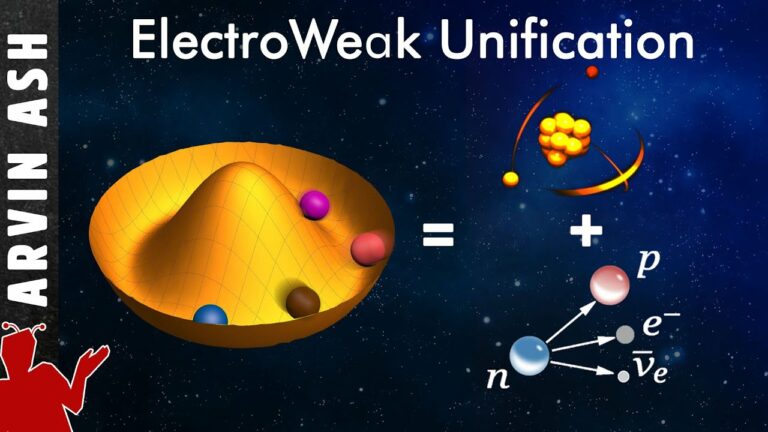How 2 Fundamental Forces Unite: Electromagnetism & The Weak force – Electroweak force
What is the Electroweak force? Electroweak theory explained: At the moment of the Big Bang, all 4 fundamental forces were probably the same. But as temperatures and energies lowered, the forces separated into distinct interactions of their own.
The energies at which electromagnetism and the weak force unite s something we can simulate in particle accelerators such as the Large Hadron collider in Geneva. But these two forces appear to be very different, so how do they unite?.
Gauge bosons – like photons mediate the electromagnetic force, and the W and Z bosons mediate the weak nuclear force. The exchange of the virtual versions of these particles confer the appropriate force. So for example, when two electrons are near each other, their repulsion is due to the exchange of virtual photons.
The weak nuclear force also works via the exchange of a virtual W or Z boson. In the beta decay of a neutron, one of its down quarks turns into a up quark by emitting a W- boson. This turns the Neutron into a proton. This W- boson almost immediately decays into an electron and an anti-neutrino. So what we detect in this decay is the electron and the antineutrino. The virtual particle is not detectable. The weak force is unique in this respect in that it is the only force which can change the identity of an elementary particle.
One big problem in uniting the electromagnetic force with the weak force is the fact that photons are massless, but the W and Z bosons are very massive – their masses are about 80 and 90 Giga electron volts or GeV. This is over 80 times the mass of a proton.
American Physicist Sheldon Glashow had noticed that even though electromagnetism is millions of times stronger than the weak force at large scales, the strengths of both forces appeared to be identical at very small lengths – about 1/1000th the width of a proton, suggesting a point where the two forces may merge as one.
Glashow showed that an acceptable theory for the unification of the weak and electromagnetic interactions could be found where the two forces are treated together as one – as an electroweak force. And his model predicted 4 bosons that would mediate this force. These bosons were called W1, W2, W3, and B.
There were two problems with his model. First it predicted a third weak force neutral Boson, now called the Z boson, which was not predicted by any theory at that time. The other was that Glashow’s model only worked if all 4 Bosons were massless. One can call this masslessness, a kind of symmetry.
But this did not fit observations. Something had to break this symmetry because the weak force was weak and interacted only at very small distances, indicating that its mediating bosons had to be massive. Glashow could not find the right mechanism for making the 4 massless bosons from his electroweak theory into the 3 heavy weak force bosons and the massless photon.
Three years later in 1964, Robert Brout and Francois Englert in Brussels and Peter Higgs developed a mechanism whereby mass could be given to elementary particles while maintaining a meaningful theory. The Brout-Englert-Higgs (BEH) mechanism employed the properties of a field (what is now called the Higgs field) to break the symmetry, and it predicted another massive particle, the Higgs boson.
In 1967 and 1968, Pakistani physicist Abdus Salam and American physicist Steven Weinberg took the ideas of the Higgs mechanism, and combined them with Glashow’s ideas to show how Glashow’s 3 weak force mediating particles could gain mass, while the photon of electromagnetism could remain massless, in the same theoretical framework. This is the basis of what is now electro-weak theory.
So now the question is, how does the Higgs mechanism give rise to masses in the 3 weak force particles, but not the photon. At energy scales above 160 GeV, the Higgs potential looks like a normal field potential, and does not confer mass. But at energies below about 160 GeV, the Higgs potential looks like a sombrero. That’s why this is called the “Mexican hat.”
The way the three Glashow particle interact with the Higgs potential determines the masses of the gauge bosons that we observe for the weak force (W+, W-, Z bosons), and for electromagnetism (photons). All 4 particles emerge from the same underlying principle.
Do not forget to share your opinion with us to provide you with the best posts !




0 Comments